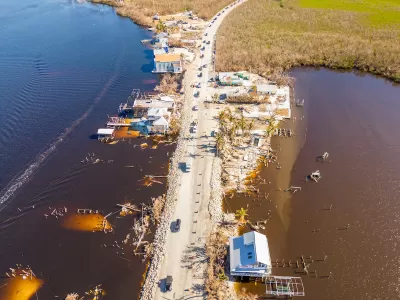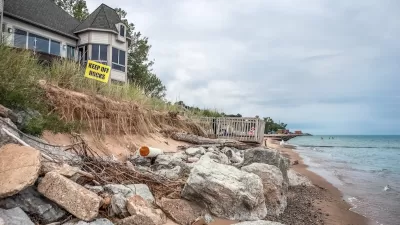Many communities at increased risk of flooding and wildfires will need to relocate. Here’s how local and regional governments can prepare.

A report from the National Academies of Science, Engineering and Medicine (NASEM) urges coastal communities facing rising sea levels and other areas at risk from extreme weather to prepare for the possibility of having to relocate to adapt to the changing climate and landscape.
As Kaitlyn Levinson explains in Route Fifty, “Researchers estimate that the sea levels along the U.S. coastline could rise by up to 12 inches by 2050—an alarming progression considering that’s the same increase documented between 1920 and 2020.” Meanwhile, increasingly destructive wildfires are making some western towns unlivable. The report notes that inland communities will also need to prepare for increased migration and demand for essential services.
One way for communities to prepare is to conduct a land suitability analysis of potential relocation sites to ensure they can support the infrastructure needed. “In their relocation plans, officials should also consider amending or adopting rules on zoning, land acquisitions or open space management, the report said. For instance, policymakers can restrict future development in an area a community has moved from to prevent newer buildings from climate risks.” Governments are also creating property buyback programs to soften the impact of relocation and assist residents who would be financially burdened by the moving process.
FULL STORY: Easier said than done: Tips for community relocation amid a changing climate

Manufactured Crisis: Losing the Nation’s Largest Source of Unsubsidized Affordable Housing
Manufactured housing communities have long been an affordable housing option for millions of people living in the U.S., but that affordability is disappearing rapidly. How did we get here?

Americans May Be Stuck — But Why?
Americans are moving a lot less than they once did, and that is a problem. While Yoni Applebaum, in his highly-publicized article Stuck, gets the reasons badly wrong, it's still important to ask: why are we moving so much less than before?

Research Shows More Roads = More Driving
A national study shows, once again, that increasing road supply induces additional vehicle travel, particularly over the long run.

Minneapolis Bans Rent-Setting Software
Four cities have enacted restrictions on algorithmic software that can inflate rent costs.

Oakland to Add 244 New EV Chargers
Oakland plans to launch its new charging network at eight locations by the end of 2025.

Jane Goodall Inspires with Message of Hope, Resilience, and Environmental Action
Speaking in Pasadena, Jane Goodall offered a hopeful and inspirational message, urging global compassion, environmental responsibility, and the power of individual action to shape a better future.
Urban Design for Planners 1: Software Tools
This six-course series explores essential urban design concepts using open source software and equips planners with the tools they need to participate fully in the urban design process.
Planning for Universal Design
Learn the tools for implementing Universal Design in planning regulations.
Heyer Gruel & Associates PA
City of Moreno Valley
Institute for Housing and Urban Development Studies (IHS)
City of Grandview
Harvard GSD Executive Education
NYU Wagner Graduate School of Public Service
City of Cambridge, Maryland
Newport County Development Council: Connect Greater Newport





























